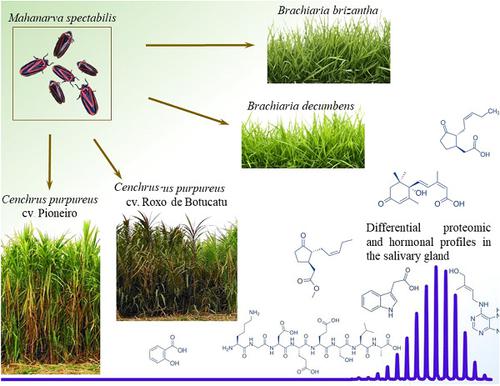当前位置:
X-MOL 学术
›
Arch. Insect Biochem. Physiol.
›
论文详情
Our official English website, www.x-mol.net, welcomes your
feedback! (Note: you will need to create a separate account there.)
Protein and phytohormone profiles of Mahanarva spectabilis salivary glands infesting different forages
Archives of Insect Biochemistry and Physiology ( IF 1.5 ) Pub Date : 2021-02-12 , DOI: 10.1002/arch.21773 Luana P. Monteiro 1 , Neilier R. Silva Júnior 1 , Camilo E. Vital 1 , Rafael A. Barros 1 , Edvaldo Barros 2 , Alexander M. Auad 3 , Jorge F. Pereira 3 , Humberto J. de O. Ramos 1 , Maria G. de A. Oliveira 1
Archives of Insect Biochemistry and Physiology ( IF 1.5 ) Pub Date : 2021-02-12 , DOI: 10.1002/arch.21773 Luana P. Monteiro 1 , Neilier R. Silva Júnior 1 , Camilo E. Vital 1 , Rafael A. Barros 1 , Edvaldo Barros 2 , Alexander M. Auad 3 , Jorge F. Pereira 3 , Humberto J. de O. Ramos 1 , Maria G. de A. Oliveira 1
Affiliation

|
Given the importance of pastures for feeding cattle, the study of factors that affect their productivity is essential to get plant material of higher nutritional quality. Thus, the study of insect–plant interaction is important for the development of control strategies. Pasture spittlebugs affect forage grasses causing severe damage. We tested hormone and protein profiles differentially expressed in the salivary glands of Mahanarva spectabilis when fed with different pasture genotypes. The LC/MS approaches combined with bioinformatics tools were used to identify the mains biological processes in the salivary glands. The grouping revealed a greater number of proteins involved in biological processes of metabolic synthesis, biotic/abiotic stress, and ion transport across the membrane. The proteomic profiles were altered when insects were fed with different grasses. We also detected phytohormones in the salivary glands involved in the modulation of defense responses in host plants. These results allowed the analysis of important biological processes such as cell homeostasis, stress proteins, nucleic acid metabolism, regulation of muscle contraction, and transport and export of biomolecules. This represents an important advance in the understanding of the plant–pest interaction and can contribute to the choice of target elicitors, which allow effective strategies in the control of pasture spittlebugs.
中文翻译:

感染不同草料的Mahanarva spectabilis唾液腺的蛋白质和植物激素谱
考虑到牧场对饲养牛的重要性,研究影响牧场生产力的因素对于获得更高营养品质的植物材料至关重要。因此,昆虫与植物相互作用的研究对于控制策略的发展很重要。牧场的臭虫影响牧草,造成严重破坏。我们测试了Mahanarva spectabilis唾液腺中差异表达的激素和蛋白质谱当饲喂不同牧场基因型时。LC / MS方法与生物信息学工具相结合,用于鉴定唾液腺中的干线生物学过程。分组揭示了更多的蛋白质参与代谢合成,生物/非生物胁迫和跨膜离子转运的生物过程。当用不同的草饲喂昆虫时,蛋白质组学特性会发生变化。我们还检测了唾液腺中的植物激素,这些植物激素参与宿主植物防御反应的调节。这些结果允许对重要的生物学过程进行分析,例如细胞稳态,应激蛋白,核酸代谢,肌肉收缩调节以及生物分子的运输和输出。
更新日期:2021-03-11
中文翻译:

感染不同草料的Mahanarva spectabilis唾液腺的蛋白质和植物激素谱
考虑到牧场对饲养牛的重要性,研究影响牧场生产力的因素对于获得更高营养品质的植物材料至关重要。因此,昆虫与植物相互作用的研究对于控制策略的发展很重要。牧场的臭虫影响牧草,造成严重破坏。我们测试了Mahanarva spectabilis唾液腺中差异表达的激素和蛋白质谱当饲喂不同牧场基因型时。LC / MS方法与生物信息学工具相结合,用于鉴定唾液腺中的干线生物学过程。分组揭示了更多的蛋白质参与代谢合成,生物/非生物胁迫和跨膜离子转运的生物过程。当用不同的草饲喂昆虫时,蛋白质组学特性会发生变化。我们还检测了唾液腺中的植物激素,这些植物激素参与宿主植物防御反应的调节。这些结果允许对重要的生物学过程进行分析,例如细胞稳态,应激蛋白,核酸代谢,肌肉收缩调节以及生物分子的运输和输出。











































 京公网安备 11010802027423号
京公网安备 11010802027423号